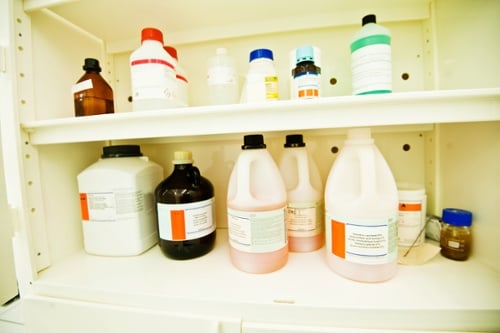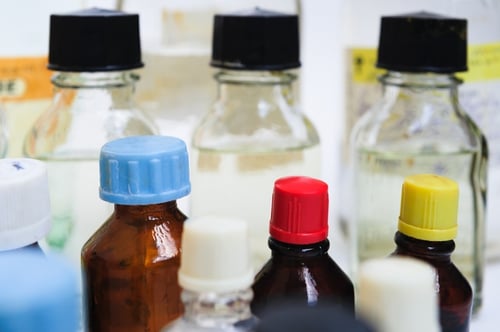So, you’re wondering what to do with your empty chemical containers? Whether they’re IBCs, bottles or plastic containers, there are still risks associated with empty chemical packages. While you may not be able to see (or smell) the hazardous substance, don’t be fooled into thinking that these empty vessels are safe to be handled, stored or discarded. To maintain workplace safety, it’s important to understand what you can do to control the risks of fire, explosion, toxic poisoning, asphyxiation and other serious chemical hazards when dealing with empty chemical containers. In this post, we’ll be looking at how you should be handling empty chemical containers, so you can minimise the likelihood of these hazards occurring at your workplace or remote job site.
What Are The Risks Associated With Empty Containers?
Each chemical class poses a certain range of key risks, however, each particular chemical product will pose a unique severity of risk.
When determining the hazards associated with your stored chemicals (even when the containers are empty), you’ll have to first understand the chemical hazards.
While this is not a comprehensive list, these are the key concerns associated with various dangerous goods classes that you may commonly find on the job site:
- Class 3 Flammable Liquids – ignition, asphyxiation, environmental contamination
- Class 6: Toxic Substances – human harm through ingestion, inhalation or contact with skin
- Class 8: Corrosive Substances – corrosion of living tissue, metal and other materials
While these risks are applicable to any quantity of chemical, it’s important to note that even the smallest volume of liquid or chemical residue can still create big issues for the organisations that carry them.
For example, toxic substances in any quantity, if they meet the eyes, skin, digestive system or respiratory tract of workers, can cause serious human harm – and become potentially fatal. Likewise, if toxic substances seep into soil or travel into waterways (if an empty chemical package has been discarded), these toxic substances can pollute animal and marine life, as well as the natural environment.

Toxic chemicals, in any quantity, can attack the human body, causing acute health issues.
Corrosive substances, due to their ability to quickly damage and destroy human skin, living tissue, metal, stone and other materials, can still create safety issues if small amounts of chemicals are found in the discarded containers. Vapours, residue and corrosive liquids, even in tiny amounts, can still create health issues and be responsible for the corrosion of property including vehicles and equipment.
Flammable liquids are known for their ability to produce sufficient flammable vapours to cause ignition, even at regular working temperatures (the flashpoint of the substance). Due to this risk, Class 3 liquids are particularly volatile and must be managed in a compliant way to avoid incidents of fire.
Flammable vapours can escape when a drum or container is open, with even small amounts of liquid being able to create fire, flashback and explosion (if emitted vapours meet an ignition source). Therefore, unwanted chemical packages that are sitting in waste disposal areas, loading docks, outdoors or in other work areas, still can ignite in the presence of an ignition source. Flashback can also occur if liquids spill out of the empty containers, creating a vapour trail that can ignite and send flames back to the empty flammable container.
Ignition sources aren’t just obvious things like a lit cigarette or a blow torch. In fact, ignition sources in the workplace can be everywhere — from heated surfaces to power points and portable electrical equipment.
If your discarded chemical containers are left lying around, they can still create serious incidents that will impact the safety and compliance of your workplace.
How To Handle Empty Chemical Containers
The flammability, toxicity or corrosive nature of your chemicals does not disappear once your container has run out of chemicals.
Accidents that can cause severe human harm can occur if empty chemical packages are left in unsafe conditions, such as outside in a waste refuse area or within a skip or bin.
Alternatively, if the packages are re-used for other chemicals, incompatibility issues and dangerous reactions can occur when unsuspecting staff are using these containers.
-1.jpg?width=500&name=Responding%20to%20a%20flammable%20liquids%20spill%20(1)-1.jpg)
Dangerous chemical reactions, and incidents such as fire or explosion, can still occur if empty flammable liquid containers are left lying around the worksite.
There are some specific requirements that relate to used chemical packages within the relevant Australian Standard.
Handling and Storing Empty Flammable Liquids Containers
If you’re working with Class 3 Flammable Liquids, the Standard AS 1940:2017 – The storage and handling of flammable and combustible liquids, explains that:
- Empty flammable packages must retain the label until they have been decontaminated or gas-freed
- Once the package has been decontaminated or gas-freed, the label may be removed or obscured
- Used packages, whether they are partly or completely emptied, must be re-closed unless they have been decontaminated or gas-freed
- Used packages should be stored and handled as if they were still full of Class 3 liquids
Handling and Storing Empty Toxic Chemical Containers
For toxic substances, leaks and spillage can cause a range of issues from human harm to environmental contamination. Empty and discarded containers must undergo a treatment before they can be re-used or placed in the waste disposal system.
AS NZS 4452:1997 – The storage and handling of toxic substances, details the requirements for empty toxic containers.
In Section 6.4.3 Package stores, it explains that:
- Toxic packages that have been opened or partially used must be clearly identified
- Labels must remain on emptied containers until the containers have been decontaminated
- Once decontaminated, the toxic containers can have the labels removed or obscured
- Unless the empty container has been decontaminated, it must treated as though it still contains toxic chemicals (however, it does not need to be kept in a compound)
Handling and Storing Empty Corrosive Substance Containers
Due to the risk to people, property and the environment, corrosives also have specific requirements that relate to empty drums or containers.
Section 6.9.3 Procedures for packages stores, in AS 3780:2008 - The storage and handling of corrosive substances, explains that:
- Any package that has been opened must be securely closed after use
- Any leaks or spillage must be neutralised to decrease risk
- Packages that have been opened or partially used must be clearly identified
- Empty corrosive substance containers must be treated as though they still hold corrosive chemicals (however, the containers don’t have to be kept in bunds)
- Corrosive containers must be decontaminated before labels can be removed or obscured
What Is The Pre-Disposal Treatment?
Before empty containers are disposed, it’s important that the proper pre-disposal treatment is conducted to reduce the chemical risks posed by the remaining vapours and residue.
We’ll explain the pre-disposal treatments for flammable liquids, corrosive substances and toxic chemicals below.
Pre-Disposal Of Flammable Containers
Flammable chemical containers must be cleaned, then punctured or crushed for disposal.

Empty containers, whether they're bottles or IBCs, must undergo a pre-disposal treatment.
You should conduct a waste management assessment to see if recycling of materials is appropriate, which includes any residues for spillage, and contaminated equipment or clothing.
REMEMBER: Identify and isolate any type of ignition source in your workplace, as it may still spark a fire or explosion during the pre-disposal process.
Pre-Disposal Of Toxic Containers
To decontaminate empty toxic substance containers, the Standard explains the pre-disposal process. This involves:
- Triple rinsing with appropriate solvent
- Washing
- Chemical neutralisation
- If not intended for re-use, the container must be drained, punctured (and preferably crushed) so it can’t be re-used
IMPORTANT: A good tip for cleaning empty chemical drums and containers is to treat them the same way that you would your bunded storage cabinets or the bund in your outdoor chemical containers.
If you’re wiping out your bund and decontaminating it, take the same housekeeping method and apply it to the decontamination of your containers and drums.
Pre-Disposal Of Corrosive Containers
Empty corrosive chemical containers can be decontaminated by a chemical treatment or simply washing them out with water, prior to their compliant disposal. However, great care must be taken to ensure that the corrosives don’t escape the work area or travel down drains into waterways.
If the container is not to be refilled with the same substance, then the labels must be removed or destroyed. When the container is not required for reuse, it must be punctured before it is disposed of safely.
REMEMBER: Create procedures for staff to follow that allows for the safe wiping out, decontamination and disposal of unwanted chemical containers. Consult with the waste disposal authority, EPA and health department, where appropriate, to determine the safest method of disposal. You may also gain information from the chemical supplier, environmental service company or waste disposal businesses servicing your site.
Ensuring Safety and Compliance During The Disposal Process
Chemical safety doesn’t stop once the liquid chemical runs out. Empty containers can still cause major incidents such as human harm, property damage and environmental contamination if they’re not handled correctly. By following the pre-disposal treatments as specified in the Australian Standards, and consulting with your local authorities, you can ensure that your empty chemical containers remain safe throughout the disposal process.
Like to learn more about chemical safety? Our eBook will help you better understand the risks associated with hazardous chemicals and help you reduce risk through our 4-step methodology. Grab your copy for free today by simply clicking on the image below.
Joining the team as a Dangerous Goods Storage Consultant, Melissa Hampton became Storemasta's Marketing Manager in late 2021. With extensive knowledge and experience in chemical compliance, Melissa is responsible for leading the Marketing team and helping shape their marketing strategy. In her spare time, you can find Melissa hiking, swimming and enjoying the great outdoors in beautiful north-west Tasmania.
